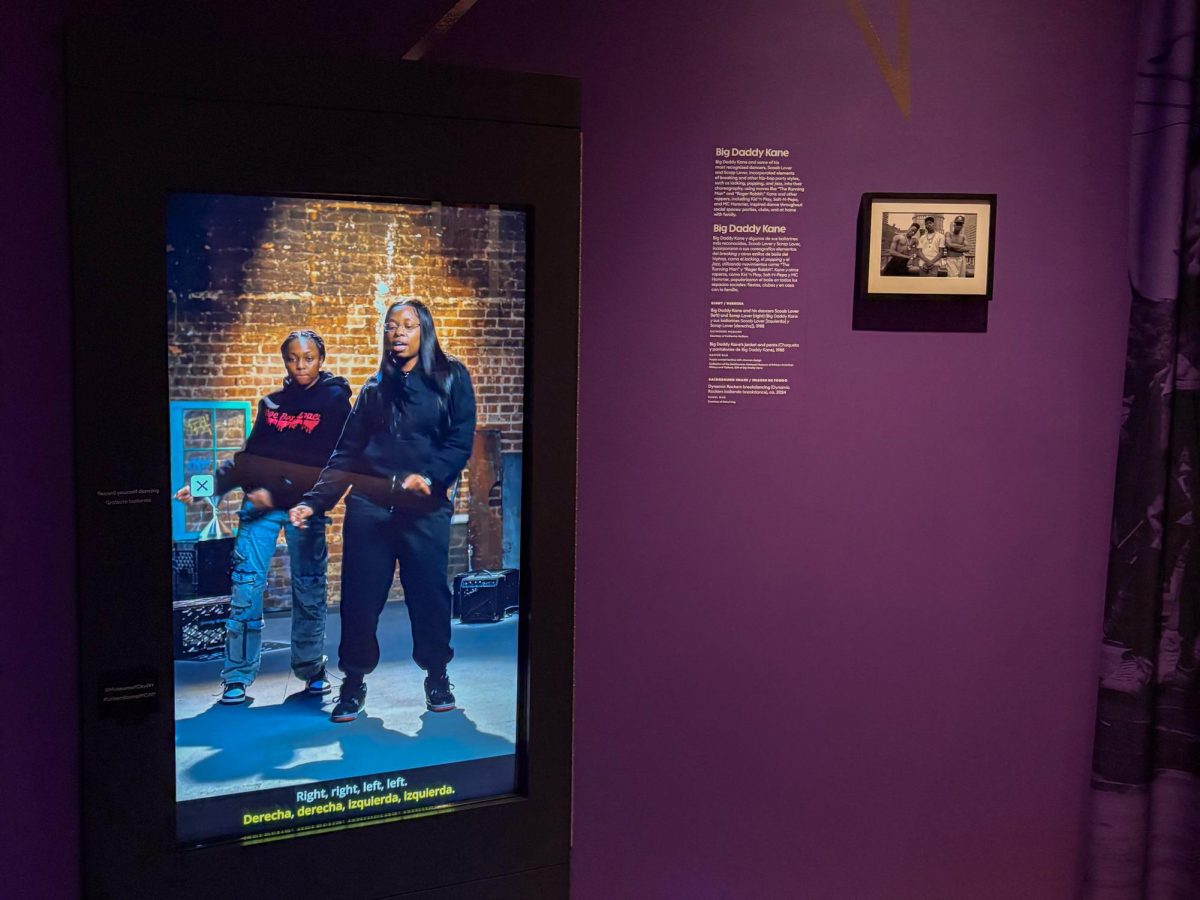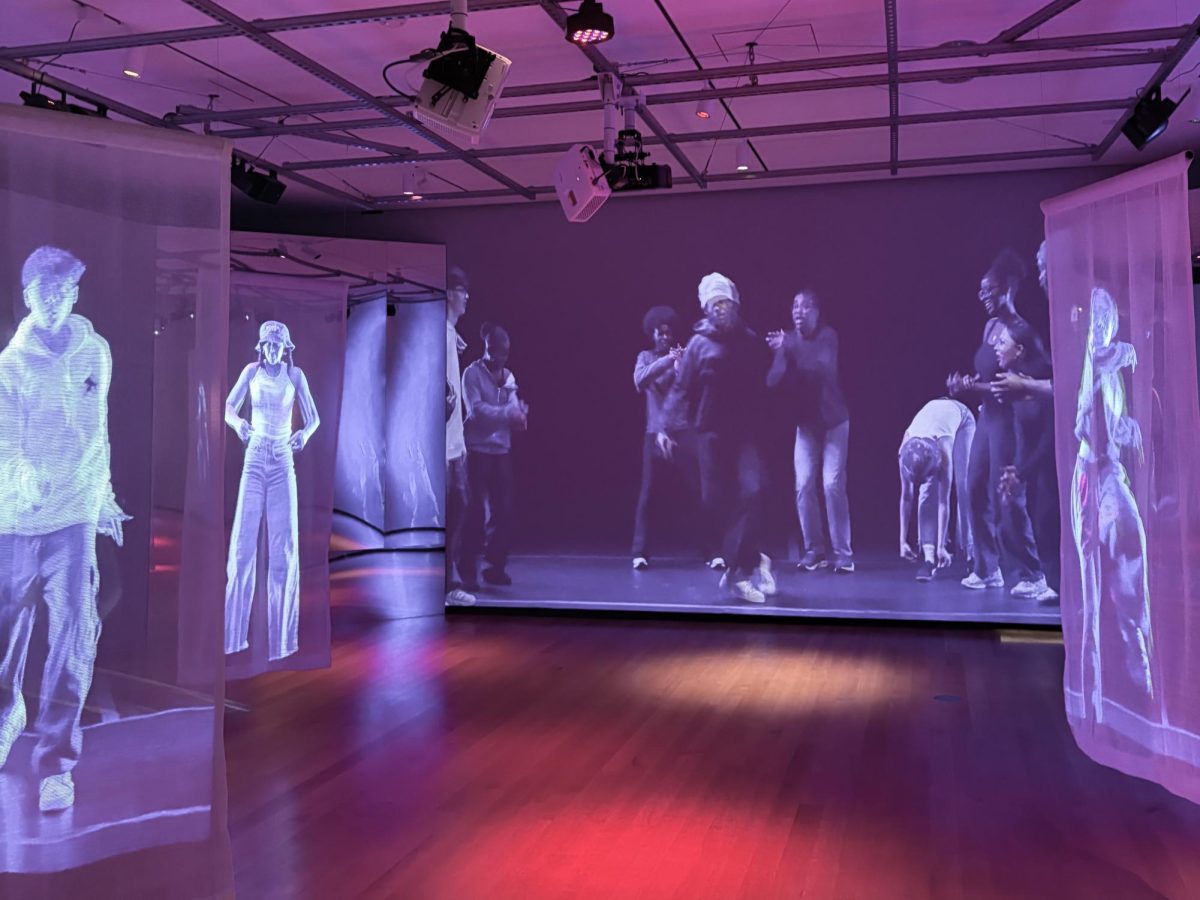If going to a history museum conjures up images of standing still in silence and squinting at black and white photos, it is time to refresh your perception. Derrick León Washington, anthropologist and curator of “Urban Stomp: Dreams and Defiance on the Dance Floor” at the Museum of the City of New York (MCNY), wants “more out of dance” and museum exhibitions.
“I was really persistent that this is going to change how exhibitions are done and what’s included in museums,” Washington said.
The exhibit, in collaboration with the Institute of Jazz Studies at Rutgers University-Newark, opened last April and is on view through February 2026. It dives into the history of social dance in New York City, with a focus on the role of these dances as community builders, catalysts of social change and stimulators of what Washington describes as “defiant joy.”
“Urban Stomp” is the latest development in a years-long project for Washington. His work began in 2018 under the name “Urban Stomp: From Swing to Mambo,” but has always been about more than just these styles. It examines cultural connections across African American, Caribbean, Latin and Jewish communities in the city.
The exhibition had an important focus on dances where “people are negotiating power, space, race and even citizenship.”
The project developed educational programming in neighborhoods where these dances were created, including the Bronx, Harlem and the Lower East Side, with the goal of tracing the ways in which music and dance represent the larger history of New York City. This programming led to a documentary and an evening of performance at Lincoln Center in 2019.
Then, in 2024, Sarah Henry, former chief curator and deputy director of MCNY, reached out to Washington about creating an exhibit on social dance at the museum (he had curated there once in 2017 for an exhibition entitled “Rhythm and Power: Salsa in New York”). It was an opportunity to highlight an often underappreciated part of our city’s history.
According to Washington, before “Urban Stomp,” there had not been much focus in museums on the history of New York’s social dance scene, which he said “has always been part of New York City’s history.”
With a history so vast, and only two galleries and a connecting hallway to work with, not every dance style could be featured. When it came to making the final decisions, Washington said the idea of “dreams and defiance” became a major factor. The exhibition had an important focus on dances where “people are negotiating power, space, race and even citizenship.” Each dance included is vital to the story because, according to Washington, “they all have an aspect of them that goes beyond just steps. They have an aspect of sociality, of anthropology, of ‘Why are people still practicing them?’”
Different colored walls separate the styles into sections, emphasizing the theme of change. The pink walls at the beginning focus on the “Balls, Ballrooms, and Bars” of the 19th century — everything from the formal balls of the elite to dances hosted by workers’ unions to the start of ragtime. On the yellow walls, the exhibition dives into the jazz age when swing, tap and the Lindy hop developed alongside piano jazz and the music of Louis Armstrong and big bands. On the red walls is the section titled “¡Wepa!”, which highlights the wide array of styles brought to the city by Afro-Latin communities, including tango, salsa, mambo (also called “salsa on two”), bachata and merengue. On the purple walls: “Cypher,” the term for a dance space (often a circle) where dancers share their skills and create a space of “radical inclusivity.” The section highlights styles like hustle, hip hop and vogue, all of which originated in the same small area of the Bronx. This section also features “digital dance floors” — social media spaces that make up a large part of the way in which social dancers connect today.
“Curating where there’s actual dance and music in the galleries. Curating to where you have photography, but you also have different objects.” Derrick León Washington, Curator
The blue walls of the second gallery showcase the social dance climate of present-day New York City, a remarkable change from the intensely socially stratified city of the start of the exhibit. This section asks, “Are we All-City Yet?” and is labeled as a “sampling of the many examples of cross-fertilization that appear on New York City dance floors everyday.” These are dances that are shared at neighborhood events, religious spaces and at family gatherings, like the emerging practice of traditional Arab Dabke dancing with remixed music, or Chinatown’s block parties that play everything from Cantonese pop music to Bhangra made in New York City.
“Urban Stomp” is truly like no other exhibit; there is a feeling of complete immersion, both in history and in a story still unfolding.
“The idea of ‘Urban Stomp,’ it’s the program, but it’s also the way of curating,” Washington said. “Curating where there’s actual dance and music in the galleries. Curating to where you have photography, but you also have different objects.”
This effort was visible throughout the exhibition: in the objects displayed, in the music played and in the many opportunities for museum-goers to join on the dance floor.
Washington’s curatorial goal was to reach beyond the traditional use of photography.
“Photography is interesting, but dance is a 3-D embodied practice,” he said.
To build the collection of displayed materials, he had to curate in a way that would truly represent the diversity of the city. Viewers can see ball gowns worn at the turn of the 20th century, as well as gowns worn at present-day vogue balls by members of the Royal House of LaBeija. There are also invitations to elite dances, musical instruments and authentic posters that make the history feel real. Some items, like the gloves and dresses from the “Balls, Ballrooms, and Bars” section, came from the MCNY archives, but for others, he had to look further, whether that be the Jazz Institute at Rutgers, other museums (Benny Goodman’s clarinet is on loan from The Metropolitan Museum of Art) or private donors who own these remarkable pieces.

Beyond the physical items, music was vital to the “Urban Stomp” experience.
“For many of the styles, you can’t separate the music and the dance,” Washington said.
The music makes the exhibit accessible for those who do not feel an immediate connection to the dance world. In the galleries, visitors could use headphones to watch videos of the dances with their signature music, adding a whole new way of experiencing the art.
Even with all these elements, what makes the exhibit the most magical is what Washington described as “embodied learning.” “Urban Stomp” includes more than 20 screens placed throughout the galleries for visitors to learn the basics of most of the dance styles discussed on the walls. Washington made clear that these are not meant as “movies,” but instead as an invitation to join in.
The invitation is also extended through community programming, which has so far included events like bachata instruction during Hispanic Heritage Month, a Lindy hop-focused tour (with dancing at the end) and classes in coordination with the Ailey Extension program for National Dance Day.
Katherine Jimenez, a lifelong dancer and instructor, taught a class called “NY Style Mambo” on National Dance Day. As an instructor, Jimenez loves seeing how learning new social dance styles provides opportunities for “empathy” and “connection.”
The dances showcased through the galleries are not only pieces of New York City’s history, but stories of marginalized communities finding power and creating connections on the dance floor.
As for the power of sharing this knowledge with all New Yorkers through “Urban Stomp,” “it’s really just like a reminder of all of our history, so that it doesn’t get lost with future generations,” Jimenez said.
“Urban Stomp: Dreams and Defiance on the Dance Floor” is an incredible and much-needed exhibit for our time. It is the story of New Yorkers breaking down social boundaries defined by race, religion, ethnic background, sexual orientation, gender identity and ability through a community practice of dance. The dances showcased through the galleries are not only pieces of New York City’s history, but stories of marginalized communities finding power and creating connections on the dance floor, all in the practice of “defiant joy.”
“I don’t want dance to be used as just something superficial, because dance can be just as deep as a speech or a song or a protest song,” Washington said.
Avoiding superficiality can be hard within the walls of a museum space, but “Urban Stomp” transcends the traditional format.
The exhibit culminates with a dance space called “All Dancing Allowed,” which references New York City’s restrictive 1926 Cabaret Law. Visitors can switch out pretend records to change the music and the dance style that is being shown on projected screens. Then, they can let loose on the dance floor. The projections, created by Earthbound Productions, show a combination of professionals and newcomers, an important reminder “Urban Stomp” is not just history, it is an invitation into the world of social dance.
“Urban Stomp” is on view through February 2026, and Fordham students can get in with discounted tickets (student ID required) or for free on Wednesdays. Those interested can also purchase the companion book “Inside Urban Stomp” to dive deeper into the exhibition, or keep up to date with events at the Museum of the City of New York.

